
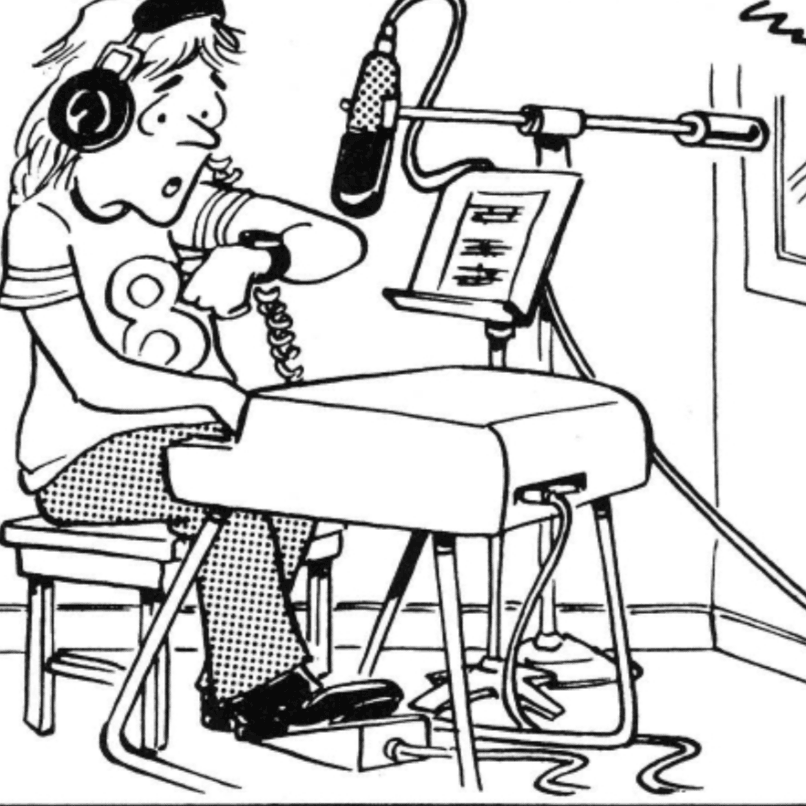
Lots of fictional characters have released albums, but none are nearly as good as the one released by Jimmy Thudpucker.
Although I have a lifelong love for comics, and an above average knowledge of the history of the newspaper comic pages, the long running classic comic strip Doonesbury, by Gary Trudeau, is not one that I have had any sort of working knowledge of. A big part of that has to do with lack of exposure to it during a time when I’d be able to understand it. When I was growing up, Doonesbury was published daily in the Toronto Star, which was not a newspaper we got in our home. Our house saw The Peterborough Examiner, and on weekends, The Toronto Sun, which did not carry Doonesbury. However, on the rare occasion that I did get the Toronto Star comic section, which was always a treat as it was filled with comic strips that were unknown and foreign to me, I was far too young to understand the comedy or satire of Doonesbury. Being under the age of ten, I preferred comics that could be enjoyed by children, such as Garfield or Peanuts or Marmaduke. But as I grew up and graduated towards more sophisticated comic strips, such as Bloom County and Calvin and Hobbes, somehow Doonesbury always escaped my radar. It’s just a comic that I never crossed paths with…until now.
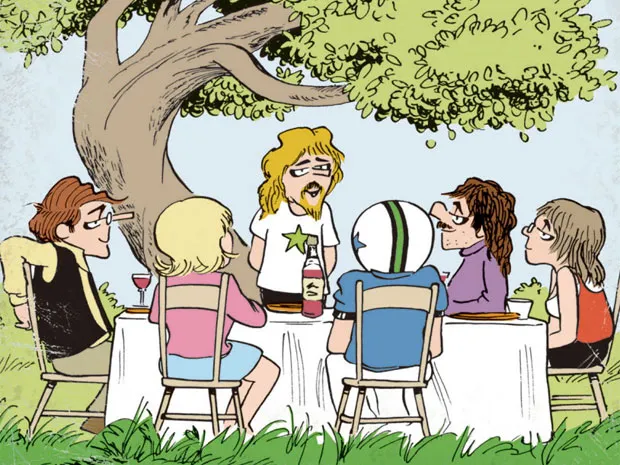
When I came across “Jimmy Thudpucker’s Greatest Hits” during a visit to Ottawa’s Vertigo Records, I had no context of what the record was all about, but I was knowledgeable enough to quickly recognize Gary Trudeai’s art on the cover, and that it was tied in to the Doonesbury comic. Now I love these kinds of weird records, and with a low price on the album and money burning a hole in my picket, I threw it on top of the stack of vinyl I was buying with very little expectations for it. So, when I got it home and put it on my turn table, I was floored when I discovered that what I wrote off as a novelty album contained some of the best 70’s pop that I’ve never heard! Seriously. Every track on the record is a complete gem, but with none of the tracks breaking into the mainstream, let alone the Billboard charts, “Jimmy Thudpucker’s Greatest Hits” seems to have been long forgotten by both comic fans and music lovers. As I started to do a deep dive into the history of both the comic strip and the album in an attempt to decipher the origins of all these great songs it seemed like worm holes between our reality and the world of Doonesbury began to open up. Trying to understand “Jimmy Thudpucker’s Greatest Hits” is like peeling an onion. Layer after layer, the album is an experiment in hyperreality filled with surprises, both intentional and unintentional which has had me running down infinite rabbit holes made by an ever expanding population of bunnies.
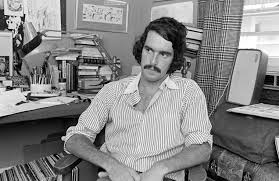
Premiering in The Yale Daily News in September 1969 under the title “Bull Tales,” Gary Trudeau began his comic strip while still in college where it quickly gained attention far beyond the campus newspaper. Initially focusing on the relationship between liberal arts major Mike Doonesbuy and his Conservative viewed football scholarship roommate B.D., the comic dealt with the politics and student culture at the fictional Walden College. Attracting the attention of United Press’ co-founder Jim Andrews, the comic strip was brought under the Syndicate’s banner and made its national debut on October 26th, 1970, in a mere 28 paper. Soon a world full of characters began to join the cast, including stoner Zonker Harris, Liberal feminist Joanie Cacus and actress Boopsie Boopstein, who all moved into one house which they called The Walden Commune. Dealing with social and cultural satire and focusing heavily on political issues ripped right out of the daily headlines, Doonesbury brought the comic pages back to an adult audience, and by the middle of the 1970’s, the strip became a critical favorite and a cult phenomenon appearing in over 1400 newspapers worldwide.
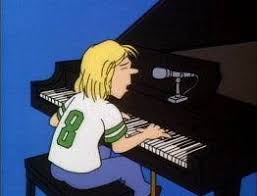
1975 proved to be a particularly good year for Gary Trudeau and Doonesbury. That year Trudeau became the first cartoonist ever to win a Pulitzer Prize for his comic strip, and a Doonesbury exhibit was held at the Metropolitan Musicum of Art in New York City. By the end of the year, Trudeau was invited to be part of the press corps that accompanied US President Gerald Ford to China. A fan of the comic, President Ford was quoted as saying “There are only three major vehicles to keep us informed as to what is going on in Washington: the electronic media, the print media, and Doonesbury, not necessarily in that order.” Meanwhile, in the comic strip, 1975 saw the introduction of musical superstar Jimmy Thudpucker.

A popular reoccurring character, Jimmy Thudpucker was introduced with his mythology already put into place, It was established in the storyline that Jimmy had first gained public attention when he performed before two thousand protestors, as well as the national guard, at a 1969 anti-war protest in front of the Washington Monument. With nothing backing him but his harmonic and acoustic guitar, Jimmy performed an original composition titled “I Do Believe,” making him an instant darling of America’s youth movement. After the protest, Jimmy gradually became a national sensation as he navigated his career through the changing cultures of 60’s idealism and 70’s excess. Although he was originally intended to be a Bob Dylan type character, Jimmy eventually morphed into a sort of cross between Billy Joel and Jackson Browne but sprouting a John Denver sort of appearance. What made Jimmy unique not only within the music industry, but also within the world of Doonesbury itself, is that he is basically a good person with pure intentions an defies any sort of cynicism. One of the subtle ways that Trudeau expressed these traits in Jimmy is seen right in the character’s design. While the majority of Trudeau’s characters are drawn with narrow eyes, which seems to depict a world weariness, children and characters with a certain innocence or sense of purity are dawn with round eyes. Jimmy is one of the few adult characters in Doonesbury that has those round eyes, and through the comic he is written with a kind and generous nature.
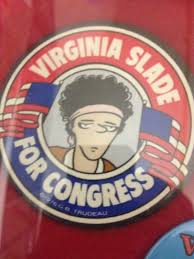
A year after Jimmy Thudpucker made his debut in the comic, he crossed over into our reality for the first time when his music went from the comic page to physical vinyl. In 1976 a major storyline was developed when Joanie’s roommate Ginny Slade ran for Congress. As a black female character, Ginny’s bid for Congress was a major political statement at that time, and with many members of the Doonesbury cast working on her campaign, the popularity of the storyline began to cross over into merchandising with “Elect Slade” t-shirts and posters popping up on college campuses. As part of the campaign, Jimmy Thudpucker was brought back to the strip where he wrote a campaign song, aptly called “Ginny’s Song.” Described as being a love song by one of Ginny’s campaign workers, the lyrics of the song were unusually intense.:
“People say my lovin’ is slowin up your show,
Well, all I can say is, baby,
It’s hard to keep my profile low.
People say, “If you love her.
Step back, and let her shine.”
I can only do harm.
With an uncommon karma like mine.
So, I’m caught in a one-sided love affair,
Trapped by a love for someone who won’t care,
And I’m lost and alone in a one-sided love affair.’
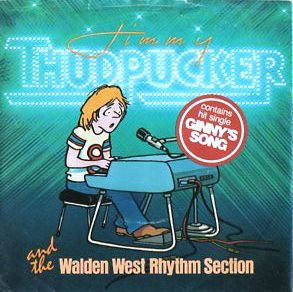
With the cottage-industry of Ginny Slade products on the market, a deal was made with Warner Brothers Records to release “Ginny’s Song,” credited to Jimmy Thudpucker, as sort of a novelty single. However, never before, or maybe even since, has a novelty single of this caliber ever been released by a comic character. Singing the original lyrics written by Gary Trudeau, the vocal track for Jimmy was provided by actor James Brewer who delivered it in a very modern and fresh fashion, emulating a lot of the top artists appearing on AM pop radio at the time. “Ginny’s Song” was produced as a completely straight track, void of any sort of cartoon gimmick, and contained the smooth sort of modern New York sound that was being produced at the time by acts like Steeley Dan or Boz Scaggs. “Ginny’s Song” is some solidly good 70’s pop. However, marketed to a niche audience, “Ginny’s Song” unfortunately did not gain any mass airplay nor attention, being primarily bought up by Doonesbury fans as a keepsake of the comic. While “Ginny’s Song” received a limited run, copies of the single are available on Discogs at criminally low prices. But despite not being a major chart success, more music was yet to come and attracting a larger demographic.
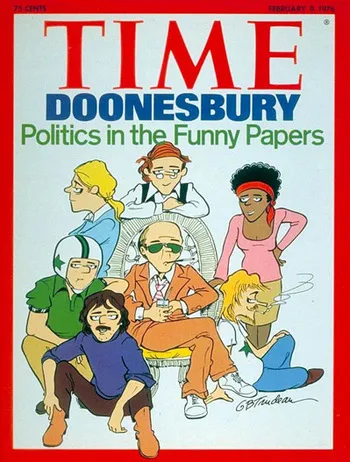
1977 was another groundbreaking year for Doonesbury, with the comic getting featured on the cover of Time Magazine, and Trudeau introducing the comic page’s first openly gay character, Andy Lippincott. While reaching its zenith in popularity, Trudeau would not shy from controversial real-world commentary, which saw the comic strip often suspended and even cancelled by newspapers across America. However, with every cancellation, another two papers would pick it up, increasing the reach of the comic. That year Gary Trudeau moved the world of Doonesbury to the screen by writing a thirty-minute animated feature titled “A Doonesbury Special.” Produced and directed by Faith and John Hubley, with assistance by Trudeau, the feature aired on NBC-TV in November 1977.
A series of vignettes commenting on the changing landscape of modern America, “A Doonesbury Special” primarily featured the main cast of the comic. However, every animated feature needs musical numbers, and that meant another chance for Jimmy Thudpucker to cross over from the page into our soundscape. In the opening sequence to the short film, Zonker turns on the television to a “Midnight Special” type program to see Jimmy singing his “latest hit” “Stop (In the Middle).” With the same production team from “Ginny’s Song” back in place, “Stop (In the Middle)” captured the themes not only of the short film itself, but of the loss of idealism amongst Americans:
“Hello, yes it’s me
I heard you on the air
You spoke of foreign wars
And how you used to care
I wouldn’t want to hold you
To words of way back when
But now is not so very far from then
Stop, in the middle of your life for asking
Who came of age with youthful rage at My Lai
Stop, in the middle of your life
Take another look at the wayward fight
Stop and remember what the winds of change were like.”
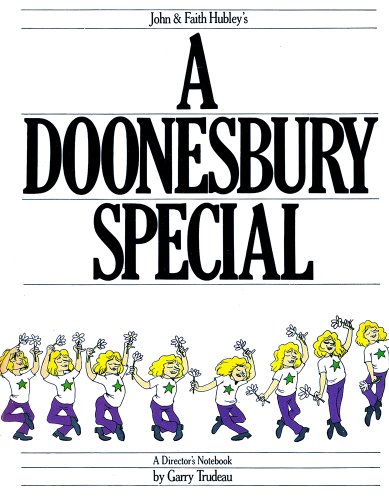
Later in the special, Jimmy gets another chance to sing when his legendary 1969 performance at the Washington Monument was featured in a flashback and his song “I Do believe” was finally heard by Doonesbury fans for the first time. Written as more of a folk-rock throwback, this time Jimmy sings in a more nasally vocal style, as an unapologetic nod to Bob Dylan, and is filled with 60’s idealism and peacenik lyrics:
I do believe,
Yes, I do believe,
A day will come,
When all of mankind will take the time to understand.
And I do believe,
Yes, I do believe,
That peace we find
Will multiply itself and us until the end of time.
Some say they know the story is over
They say the end is here and now
If only we can stop and think it over
Just try to touch each other’s lives somehow.
While it seems that it is nearly all but forgotten today, at the time “A Doonesbury Special” was immensely successful. Released theatrically in some markets, the production was nominated for an Academy Award in the category of “Best Animated Short,” and earned the Special Jury Prize at the Cannes Film Festival. Still a fun and thoughtful watch today, the film is available to view for free via YouTube.
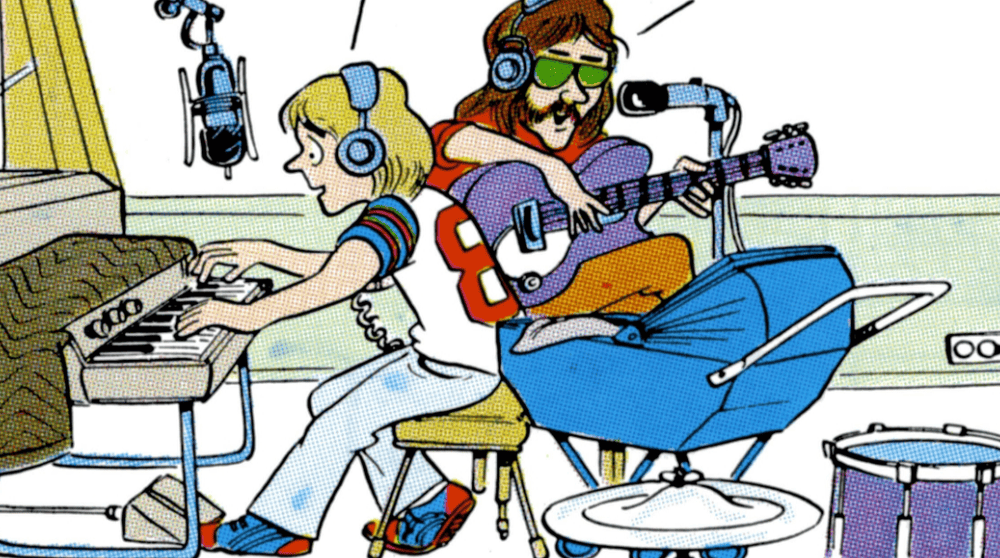
By the end of 1977, still riding high on the success of “A Doonesbury Special,” and now with three Jimmy Thudpucker singles having been produced, instead of just releasing “Stop (In the Middle)” and “I Do Believe” as another single, an entire LP of Jimmy Thudpucker songs was developed. With it being established in the comic that Jimmy was a sensation already, the concept of the album was that it would be a “Greatest Hits” package that would not only bring all the previously released songs together, but include new ones which reflect Jimmy’s narrative throughout the entire timeline of the comic strip, as well as developing new narratives for the character which hadn’t been established yet.
Of the new Jimmy Thudpucker songs, the strongest is “I Don’t Know My Love,” which expanded Jimmy’s story beyond the strip. It would be explained that the song was about Jimmy waking up after a long depression and discovering that he was questioning his life, and especially his marriage, which led to his eventual divorce. After ending his marriage, Jimmy wrote “I Don’t Know My Love,” and it became his first #1 hit song. Jimmy also sings about the pitfalls of 1970’s celebrity culture in “Take Your Life,” which is about drugs, death and emotional blackmail. Again, the songs are thoughtful and thoroughly modern. They don’t come off as music written for a fictional character but instead sound like songs that organically came from real experiences and emotions. They ae based solidly in the moment and seem to be extremely personal.
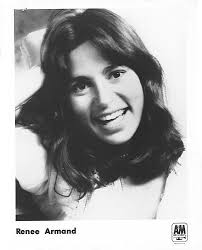
But possibly the best song on the album isn’t even performed by Jimmy Thudpucker at all. The final song on the first side, “Indian Brown” was written and, at Jimmy’s insistence, performed by session singer Renee Armand. A moving love song to an Indigenous man, “Indian Brown” is performed with so much honesty and energy that it, perhaps unintentionally, becomes the centerpiece to the album. In trying to understand how “Indian Brown” fits in the confines of the Jimmy Thudpucker mythology, I veered away from the world of Doonesbury to discover the real-life story of Renee Armand and found a new performer I want to hear so much more of.
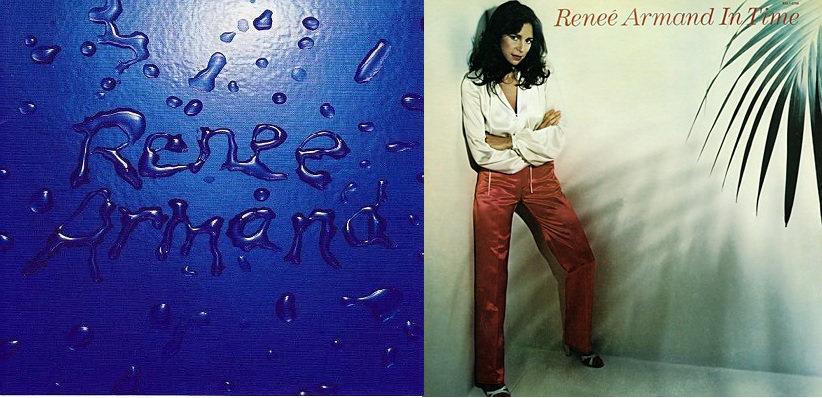
Discovered by Tony Bennet while singing at a San Francisco night club, Renee Armand was mentored by jazz vocalist Carmen McRae. Although she primarily made her career as a session singer, working for artists such as John Denver, Michael Jackson, Linda Ronstadt and Emmy Lou Harris, she also released two albums of her own, “The Rain Book” (1972) and “In Time” (1977). In fact, a version of “Indian Brown” without Jimmy Thudpucker’s vocal backups, is on “In Time,” which was released the same year and on the same label as “Jimmy Thudpucker’s Greatest Hits.” Renee would go on to briefly be a member of The Coyote Sisters, who had a minor hit in 1984 with “Straight From the Heart (Into Your Life).” But, where probably the most people have heard Renne Armand’s vocals is in the 1973 film “The Poseidon Adventure,” It was Renee who provided the vocal track for “The Morning After,” which was “lip synched” by Carol Lynley in the film (of course the version that hit on the Billboard charts was recorded by Maureen McGovern). Although her original albums are not available on Spotify, you can listen to Renee Armand’s music via YouTube and both of her albums are now on the top of my “want list” and will most likely be a part of my next Discogs order.
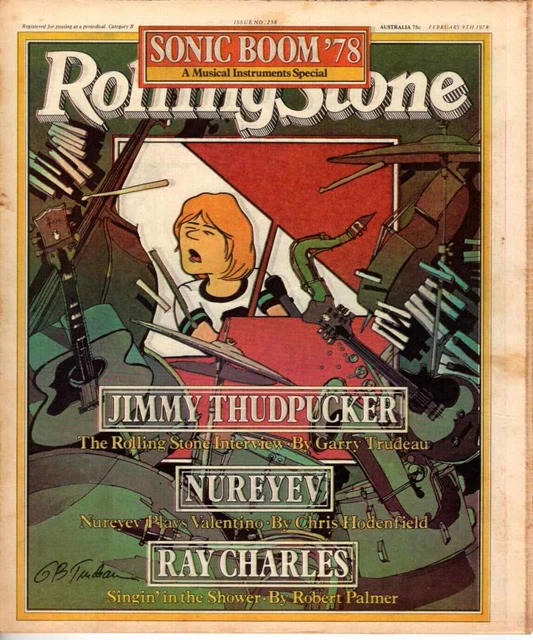
To promote” Jimmy Thudpucker’s Greatest Hits,” Gary Trudeau pushed metareality a notch further when he produced an article for Rolling Stone Magazine where he, as the interviewer, interviews Jimmy Thudpucker. Featured in the February 1977 issue of Rollin Stone, Jimmy Thudpucker was pictured on the front cover, and the article gave Trudeau a platform not only to enhance Jimmy’s character and musical philosophy even further, but also add additional context to many of the album’s songs and express his own criticism of the modern music industry which seemed to be “selling out” in terms of commodity over creativity. In the body of the interview Jimmy took open shots at Paul McCartney and Mick Jagger and was concerned with the treatment and exploitation of studio musicians. Around the same time, Trudeau began to either feature, or at least make mention, of the real-life musicians and vocalists that worked on the album within the Doonesbury comic as the people working with Jimmy Thudpucker.
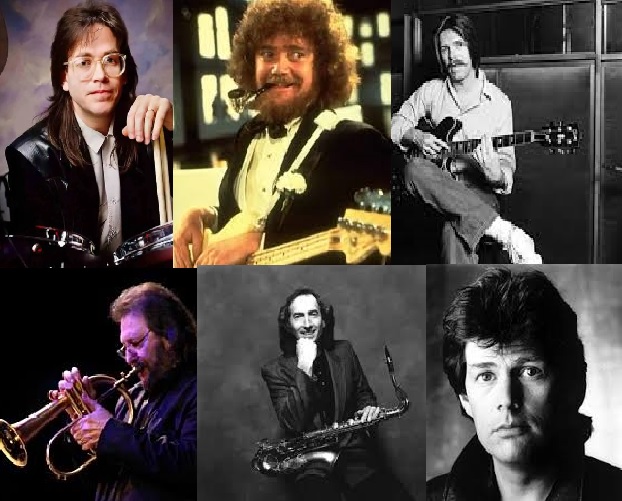
Those real-life studio musicians, called The Walden West Rhythm Section on the album, were easily the glue that made “Jimmy Thudpucker’s Greatest Hits” stick. The Walden West Rhythem Section had some of the best in the business working on the album, including drummer Jeff Pocaro who had worked with Steely Dan, and guitarist Donald “Duck” Dunn and bassist Jay “Wah Wah” Graydon, who were members of Booker T and the MG’s. In fact, Graydon was the inspiration for the album’s song “Fretman Sam,” which is Thudpucker’s tribute to the professional session musician. The album also had famed trumpeter Chuck Findley, who is best known for his flugelhorn solo on The Carpenter’s “Close to You,” and The Wrecking Crew’s saxophonist Jim Horn. Meanwhile, keyboards and synthesizers were performed by future superstar producer David Foster, who also wrote, arranged and conducted the album’s epic climatic number “Overture ‘73” which ends “Jimmy Thudpucker’s Greatest Hits” with a triumphant bang.
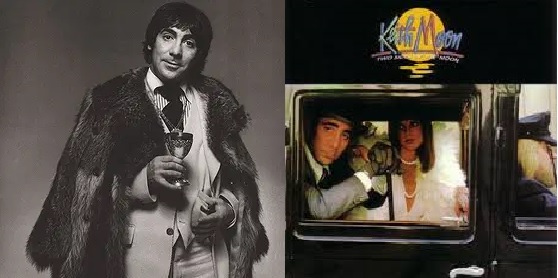
But there is one more significant player credited to the album which is a real head turner. The drums on “Ginny’s Song” is credited to Keith Moon! That’s right! The Who’s legendary Wildman, Keith Moon! Although it is a little bit convoluted, I am pretty certain I found the crosspoint where Keith Moon collided with the world of Jimmy Thudpucker. Remember, “Ginny’s Song” was first released a few years prior in early 1976, which probably meant it was recorded in 1975. Well, the producer of that single, as well as the rest of Jimmy Thudpucker’s material, was Steve Cropper, and Cropper was one of the rotating producers who was trying to hold together the creation of Keith Moon’s only solo release, “Two Sides of the Moon,” recorded and released in 1975, which was less of a recording process and more of a year long booze soaked and amphetamine driven rock n’ roll orgy. Furthermore, David Foster also crossed over as a contributing keyboardist to the Keith Moon project. So, it isn’t too far of a stretch to believe that Keith Moon may have quietly lent his talents to a novelty single by a comic character at the request of his then producer Steve Cropper. While we remember him as one of the most iconic rock n’ roll drummers of all time today, that’s the kind of thing that Keith Moon would have probably got a kick out of doing.

But despite the importance put upon session musicians by Gary Trudeau in his commentary on “Jimmy Thudpucker’s Greatest Hits”, one important player’s name was completely left off the album – the voice of Jimmy Thudpucker himself, James Brewer. Decades after the release of the album, a letter of discontent was circulated on the internet by Brewer which had a somewhat bitter tone in regard to his lack of recognition on the project:
“I’m James “Jimmy” Brewer, the singer/songwriter who co-wrote the tunes and provided the voice for “Ginny’s Song,” the single for Warner Bros.; the film, “A Doonesbury Special,” and the LP, “Jimmy Thudpucker’s Greatest Hits,” released on Windsong Records.
For reasons still unknown to me, when all three projects were unveiled, Mr. Trudeau had completely removed my name from everything and had given the credit for my work to “Jimmy Thudpucker.” There was a “rumour,” circulated via many newspapers that regularly ran Doonesbury, that Trudeau was indeed secretly Jimmy Thudpucker. A number of the songs, including the two that were used in the film, were written before I ever met Mr. Trudeau.
I was the sole participant in all three projects whose work went totally uncredited. Twenty-five years later, after countless inquiries, he acknowledged me on his website.”
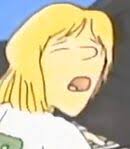
With Trudeau standing on a soap box in regard to the recognition of studio performers, it seems hypocritical that Brewer would not receive the credit he rightfully deserved. However, Trudeau was blurring the lines of reality and fiction in such an immersive way that crediting Brewer would be an admission that Jimmy was a fictional character, thus destroying the illusion he was attempting to create. It might have seemed unfair, but I can understand why Trudeau and company made the decision that they did in this regard, and I highly doubt that Brewer didn’t understand the concept going into the project. However, what is far more disappointing is that it doesn’t seem that Brewer continued recording music of the same caliber independently of the Jimmy Thudpucker project. An excellent vocalist, Brewer worked primarily in theatre and apparently has written music and developed stage musicals. I read in one source that at some point Brewer had a recording contract with Capitol Records, but despite plenty of info about his more current activities in entertainment, I can’t find any additional music or albums credited to him. If anybody can offer any further information or additional music produced by James Brewer, especially that has been released on vinyl, please shoot me a message because I’d like to hear it.
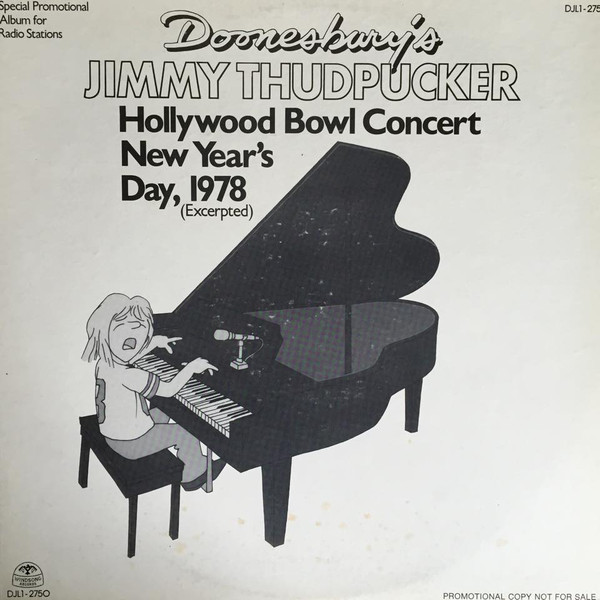
A promotional single featuring “You Can’t Fight It” and “Take Your Life” was pressed and distributed to radio stations, but neither song gained any attention preventing additional copies of the single being produced for sale in stores. However, in 1978 a special 12 inch record titled “Jimmy Thudpucker Hollywood Bowl Concert New Years Day 1978” was released which repackaged four tracks – “Fretman Sam,” “Take Your Life,” “I Don’t Know My Love” and “So Long/Overture ‘73” – along with audience noises and Jimmy Thudpucker dialogue lifted from the Rolling Stone interview that added context to the songs. Although the rarest of the Jimmy Thudpucker releases, a few copies are available on Discogs and are also surprisingly affordable. There just doesn’t seem to be a demand for these Jimmy Thudpcuker records.
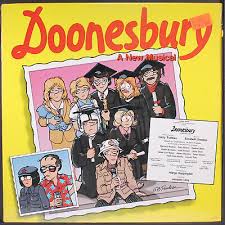
One more Doonesbury inspired record would be released in 1983 when Doonesbury crossed over from the comic pages to the Broadway stage. “Doonesbury: A Musical Comedy” was written by Gary Trudeau with music by Margo Sappington, but Jimmy Thudpucker was not a featured character in the show and didn’t have any songs on the soundtrack album. However, Jimmy continued to make appearances in the comic throughout its publication. In later comics, Jimmy struggled with staying relevant in the changing music industry, often trying to rebrand himself unsuccessfully, such as going country as Jimmy Ray Thudpucker, attempting a rap career as MC Jimmy, recording a Christmas album under the name Jimmy T., and attempting to enter the world of adult contemporary music as James R. Thudpucker. Jimmy also became an advocate for streaming, downloading and file sharing, making his music available for free on the internet as he continued to wait for the music industry to collapse on itself.
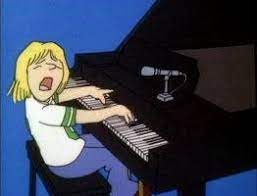
Although I had nothing but base knowledge of the existence of Doonesbury when I found “Jimmy Thudpucker’s Greatest Hits,” taking a chance on this album was one of the best blind buys I’ve ever made. An incredible overlooked album, my lack of knowledge of the source material didn’t hinder my enjoyment of the record, but by engaging with it so much, the album actually got me wanting to read Doonesbury for the first time and had me researching the history and mythology of this groundbreaking modern classic. GoComics.com, which publishes daily serialized strips, including the current run of Doonesbury, offers a subscription that allows readers full access to the entire archives of Doonesbury as well as other current and classic comic strips. This has given me the opportunity to begin Doonesbury from the start, and now I have over fifty years of strips to catch up on. Decades after the release of “Jimmy Thudpucker’s Greatest Hits,” my love for the album has proven that it was a cross over marketing tool that continues to work. While Doonesbury doesn’t seem to be a part of the cultural zeitgeist today as much as it was during the 1970’s, the music of Jimmy Thudpucker still hits, and deserves to be rediscovered.



